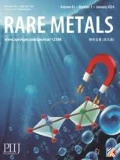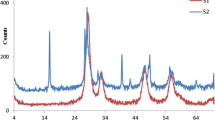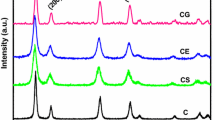Abstract
Cerium dioxide has a comparatively lower Ce4+/Ce3+ redox pair, which leaves abundant oxygen vacancies on oxide lattice, also making incorporation of foreign ion and subsequent applications feasible and convenient. In this work, a series of cerium–yttrium mixed oxides were prepared by using polyvinylpyrrolidone as major template through sol–gel, which were further employed as catalyst for dehydration of aniline with formic acid into N-phenylformamide. Characterizations reveal that synthetic samples have a variety of morphologies including nanoparticle, microflower, and uniform microrods. The monitoring of particle size, zeta potential, and ultraviolet-visible (UV–Vis) of preparative solution indicate that self-assembly of polyvinylpyrrolidone and its subsequent reaction with metal ion determines sample morphology. In catalytic dehydration, all samples show high dehydration efficiencies that are comparable to those from anhydrous Na2SO4 and combination of dicyclohexylcarbodiimide with 4-dimethylaminopyridine and dichloromethane shows better outputs than water. In association with structural analysis, cerium looks more active than yttrium, while yttrium mainly plays as a structure-directing and pore-forming agent. This study may contribute to micro-/nanofabrication of rare earth composites and their catalytic applications.
Graphic abstract












Similar content being viewed by others
References
Zhang G, Xu J, Hou Z, Wang Q. Research on micro-structure and catalysis properties of nanosized Ce1−x(Fe0.5Eu0.5)xO2-δ solid solutions. J Rare Earths. 2017;35(1):63.
Shen K, Lin J-P, Xia Q, Dai L, Zhou G-J, Guo Y-L, Lu G-Z, Zhan W-C. Tuning performance of Pd/Sn0.9Ce0.1O2 catalyst for methane combustion by optimizing calcination temperature of support. Rare Met. 2019;38(2):107.
Minaei S, Haghighi M, Jodeiri N, Ajamein H, Abdollahifar M. Urea-nitrates combustion preparation of CeO2-promoted CuO/ZnO/Al2O3 nanocatalyst for fuel cell grade hydrogen production via methane steam reforming. Adv Powder Technol. 2017;28(3):842.
Sun C, Li H, Chen L. Nanostructured ceria-based materials: synthesis, properties, and applications. Energy Environ Sci. 2012;5(9):8475.
Han X, Li L, Wang C. Template-free synthesis of uniform single-crystal hollow cerium dioxide nanocubes and their catalytic activity. Nanoscale. 2013;5(16):7193.
Yuan S, Zhang Q, Xu B, Jin Z, Zhang Y, Yang Y, Zhang M, Ohno T. Porous cerium dioxide hollow spheres and their photocatalytic performance. RSC Adv. 2014;4(107):62255.
Slavinskaya EM, Kardash TY, Stonkus OA, Gulyaev RV, Lapin IN, Svetlichnyi VA, Boronin AI. Metal-support interaction in Pd/CeO2 model catalyst for CO oxidation: from pulsed laser-ablated nanoparticles to highly active state of the catalyst. Catal Sci Technol. 2016;6(17):6650.
Wilklow-Marnell M, Jones WD. Catalytic oxidation of carbon monoxide by α-alumina supported 3 nm cerium dioxide nanoparticles. Mol Catal. 2017;9:439.
Channei D, Nakaruk A, Phanichphant S. Influence of graphene oxide on photocatalytic enhancement of cerium dioxide. Mater Lett. 2017;209:43.
Satapathy S, Ahlawat A, Paliwal A, Singh R, Singh MK, Gupta PK. Effect of calcination temperature on nanoparticle morphology and its consequence on optical properties of Nd:Y2O3 transparent ceramics. CrystEngComm. 2014;16(13):2723.
Hayashi F, Iwamoto M. Yttrium-modified ceria as a highly durable catalyst for the selective conversion of ethanol to propene and ethene. ACS Catal. 2013;3(1):14.
Fokema MD, Ying JY. The selective catalytic reduction of nitric oxide with methane over scandium oxide, yttrium oxide and lanthanum oxide. Appl Catal B: Environ. 1998;18(1–2):71.
Park J, Park M, Nam G, Kim MG, Cho J. Unveiling the catalytic origin of nanocrystalline yttrium ruthenate pyrochlore as a bifunctional electrocatalyst for Zn-air batteries. Nano Lett. 2017;17(6):3974.
Cheng W, Rechberger F, Niederberger M. Three-dimensional assembly of yttrium oxide nanosheets into luminescent aerogel monoliths with outstanding adsorption properties. ACS Nano. 2016;10(2):2467.
Englade-Franklin LE, Morrison G, Verberne-Sutton SD, Francis AL, Chan JY, Garno JC. Surface-directed synthesis of erbium-doped yttrium oxide nanoparticles within organosilane zeptoliter containers. ACS Appl Mater Interfaces. 2014;6(18):15942.
Olad A, Zebhi H, Salari D, Mirmohseni A, Reyhanitabar A. Synthesis, characterization, and swelling kinetic study of porous superabsorbent hydrogel nanocomposite based on sulfonated carboxymethylcellulose and silica nanoparticles. J Porous Mater. 2018;25(5):1325.
Taha AKT, Amir M, Korkmaz AD, Al-Messiere MA, Baykal A, Karakuş S, Kilislioglu A. Development of novel nano-ZnO enhanced polymeric membranes for water purification. J Inorg Organomet Polym. 2019;29(3):979.
Yan N, Zhang J, Tong Y, Yao S, Xiao C, Li Z, Kou Y. Solubility adjustable nanoparticles stabilized by a novel PVP based family: synthesis, characterization and catalytic properties. Chem Commun. 2009;29:4423.
Zaki T. Catalytic dehydration of ethanol using transition metal oxide catalysts. J Colloid Interf Sci. 2005;284(2):606.
Hu L, Xu S, Zhao Z, Yang Y, Peng Z, Yang M, Wang C, Zhao J. Ynamides as racemization-free coupling reagents for amide and peptide synthesis. J Am Chem Soc. 2016;138(40):13135.
Mai TT, Viswambharan B, Gori D, Kouklovsky C, Alezra V. Memory of chirality of tertiary aromatic amide: application to the asymmetric synthesis of (S)-α-methylDOPA. J Org Chem. 2012;77(19):8797.
Ojeda-Porras A, Gamba-Sánchez D. Recent developments in amide synthesis using nonactivated starting materials. J Org Chem. 2016;81(23):11548.
Dunetz JR, Magano J, Weisenburger GA. Large-scale applications of amide coupling reagents for the synthesis of pharmaceuticals. Org Process Res Dev. 2016;20(2):140.
Dine TME, Erb W, Berhault Y, Rouden J, Blanchet J. Catalytic chemical amide synthesis at room temperature: one more step toward peptide synthesis. J Org Chem. 2015;80(9):4532.
Potadar SM, Mali AS, Waghmode KT, Chaturbhuj GU. Repurposing n-butyl stannoic acid as highly efficient catalyst for direct amidation of carboxylic acids with amines. Tetrahedron Lett. 2018;59(52):4582.
Renuka MK, Gayathri V. Synthesis of secondary amides by direct amidation using polymer supported copper(II) complex. Polyhedron. 2018;148:195.
Kang B, Fu Z, Hong SH. Ruthenium-catalyzed redox-neutral and single-step amide synthesis from alcohol and nitrile with complete atom economy. J Am Chem Soc. 2013;135(32):11704.
Mia S, Dijkstra FA, Singh B. Aging induced changes in biochar’s functionality and adsorption behavior for phosphate and ammonium. Environ Sci Technol. 2017;51(15):8359.
Chen D, He D, Lu J, Zhong L, Liu F, Liu J, Yu J, Wan G, He S, Luo Y. Investigation of the role of surface lattice oxygen and bulk lattice oxygen migration of cerium-based oxygen carriers: XPS and designed H2-TPR characterization. Appl Catal B: Environ. 2017;218:249.
Pawlak DA, Woźniak K, Frukacz Z, Barr TL, Fiorentino D, Hardcastle S. ESCA studies of yttrium orthoaluminum perovskites. J Phys Chem B. 1999;103(17):3332.
Pawlak DA, Woźniak K, Frukacz Z, Barr TL, Fiorentino D, Seal S. ESCA studies of yttrium aluminum garnets. J Phys Chem B. 1999;103(9):1454.
Galindo IR, Viveros T, Chadwick D. Synthesis and characterization of titania-based ternary and binary mixed oxides prepared by the sol-gel method and their activity in 2-propanol dehydration. Ind Eng Chem Res. 2007;46(4):1138.
Lee AF, Naughton JN, Liu Z, Wilson K. High-pressure XPS of crotyl alcohol selective oxidation over metallic and oxidized Pd(111). ACS Catal. 2012;2(11):2235.
Zhang Y, Yuwono AH, Wang J, Li J. Enhanced photocatalysis by doping cerium into mesoporous titania thin films. J Phys Chem C. 2009;113(51):21406.
Imamura M, Matsubayashi N, Shimada H. Catalytically active oxygen species in La1-xSrxCoO3-δ studied by XPS and XAFS spectroscopy. J Phys Chem B. 2000;104(31):7348.
Sing KSW, Everett DH, Haul RAW, Moscou L, Pierotti RA, Rouquérol J, Siemieniewska T. Reporting physisorption data for gas/solid systems with special reference to the determination of surface area and porosity. Pure Appl Chem. 1985;57(4):603.
Hiyoshi N. Nanocrystalline sodalite: preparation and application to epoxidation of 2-cyclohexen-1-one with hydrogen peroxide. Appl Catal A: Gen. 2012;419–420:164.
Zhan H, Yang X, Wang C, Chen J, Wen Y, Liang C, Greer HF, Wu M, Zhou W. Multiple nucleation and crystal growth of barium titanate. Cryst Growth Des. 2012;12(3):1247.
Vinothkannan M, Kim AR, Nahm KS, Yoo DJ. Ternary hybrid (SPEEK/SPVdF-HFP/GO) based membrane electrolyte for the applications of fuel cells: profile of improved mechanical strength, thermal stability and proton conductivity. RSC Adv. 2016;6(110):108851.
Rodríguez-González C, Martínez-Hernández AL, Castaño VM, Kharissova OV, Ruoff RS, Velasco-Santos C. Polysaccharide nanocomposites reinforced with graphene oxide and keratin-grafted graphene oxide. Ind Eng Chem Res. 2012;51(9):3619.
Ramaprasad AT, Latha D, Rao V. Synthesis and characterization of polypyyrrole grafted chitin. J Phys Chem Solids. 2017;104:169.
Barroso-Bogeat A, Alexandre-Franco M, Fernández-González C, Gómez-Serrano V. FT-IR analysis of pyrone and chromene structures in activated carbon. Energy Fuels. 2014;28(6):4096.
Zhang H, Wang YM, Zhang L, Gerritsen G, Abbenhuis HCL, van Santen RA, Li C. Enantioselective epoxidation of β-methylstyrene catalyzed by immobilized Mn(salen) catalysts in different mesoporous silica supports. J Catal. 2008;256(1):226.
Huo W, Zhang X, Gan K, Chen Y, Xu J, Yang J. Effect of zeta potential on properties of foamed colloidal suspension. J Eur Ceram Soc. 2019;39(2–3):574.
Cheng H, Qin L, Cai P, Chen C, Wang J, Kim SI, Huang Y, Seo HJ. Charge transfer transition and energy transfer in Eu3+-doped Gd10V2O20. J Lumin. 2018;195:278.
Park J, Cullen DA, Chen J, Polizos G, Sharma J. Same solution synthesis and self-assembly of porous silica nanoparticles into microspheres. Appl Surf Sci. 2019;467–468:634.
Santos SI, Bogel-Łukasik E, Bogel-Łukasik R. The ionic liquid effect on solubility of aniline, a simple aromatic amine: perspective of solvents’ mixture. Fluid Phase Equilibr. 2012;325:105.
Chen C, Tan L, Zhou P. Approach for the synthesis of N-phenylamides from β-ketobutylanilides using dimethylformamide and dimethylacetamide as the acyl donors. J Saudi Chem Soc. 2015;19(3):327.
Acknowledgements
This study was financially supported by the Natural Science Foundation of Shaanxi Province (No. 2017JM2016), and the Fundamental Research Funds for the Central Universities (No. xjj2014005).
Author information
Authors and Affiliations
Corresponding author
Electronic supplementary material
Below is the link to the electronic supplementary material.
Rights and permissions
About this article
Cite this article
Pan, C., Huang, BH., Fan, C. et al. Cerium–yttrium binary oxide microflower: synthesis, characterization and catalytic dehydration property. Rare Met. 40, 1785–1800 (2021). https://doi.org/10.1007/s12598-020-01475-5
Received:
Revised:
Accepted:
Published:
Issue Date:
DOI: https://doi.org/10.1007/s12598-020-01475-5




